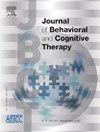Cognitive behavior therapy for treatment seeking: intervention development and empirical findings
IF 1.6
Q3 PSYCHIATRY
引用次数: 0
Abstract
Objective
Interventions have been developed to increase treatment engagement among individuals with behavioral health problems, yet over 50% of individuals do not receive treatment. New interventions are needed to address unmet treatment needs by promoting treatment-seeking behaviors.
Methods and Measures
This paper reviews the development, pilot testing, and empirical findings of Cognitive Behavioral Therapy for Treatment-Seeking (CBT-TS), a novel intervention designed to increase treatment-seeking behaviors. We discuss the findings of nine CBT-TS intervention trials among adults with a variety of behavioral health diagnoses (e.g., depression, alcohol use, suicidal ideation).
Results
CBT-TS was developed to focus on cognitive factors that predict treatment-seeking behaviors, implementation outside of existing treatment systems, flexible administration (in-person or phone), and applicability to diverse populations. CBT-TS has demonstrated efficacy in improving behavioral health treatment utilization. Populations studied include military service members, veterans and community adults presenting with alcohol use disorder, post-traumatic stress disorder, suicidal thoughts and behaviors, and comorbid diagnoses. Follow-up periods ranged from 1- to 12-months and examined the percentage of participants initiating and/or sustaining treatment engagement, qualitative findings of beliefs endorsed, and reductions in behavioral health symptoms.
Conclusions
CBT-TS shows tremendous promise as a brief, evidence-based intervention to improve treatment-seeking behaviors among diverse populations. Opportunities exist to expand CBT-TS across populations such as individuals in rural settings, and among other diagnostic groups such as individuals with chronic pain. Further study is warranted to identify reasons for the variability of treatment initiation rates and its potential to increase treatment engagement and completion.
认知行为治疗寻求:干预发展和实证研究结果
目的:为了提高行为健康问题患者的治疗参与度,已经制定了干预措施,但超过50%的患者没有接受治疗。需要新的干预措施,通过促进寻求治疗的行为来解决未得到满足的治疗需求。认知行为疗法(CBT-TS)是一种旨在增加寻求治疗行为的新型干预手段,本文综述了CBT-TS的发展、试点试验和实证结果。我们讨论了九项CBT-TS干预试验的结果,这些试验在患有各种行为健康诊断(如抑郁症、酒精使用、自杀意念)的成年人中进行。结果开发scbt - ts着眼于预测寻求治疗行为的认知因素、在现有治疗系统之外的实施、灵活的给药(面对面或电话)以及对不同人群的适用性。CBT-TS在提高行为健康治疗的利用率方面已被证明有效。研究的人群包括军人、退伍军人和社区成年人,他们有酒精使用障碍、创伤后应激障碍、自杀念头和行为,以及共病诊断。随访时间从1个月到12个月不等,并检查了开始和/或维持治疗参与的参与者的百分比,信念认可的定性结果以及行为健康症状的减少。结论scbt - ts作为一种简短的、基于证据的干预措施,在改善不同人群的寻求治疗行为方面显示出巨大的希望。有机会将CBT-TS扩展到农村地区等人群以及慢性疼痛患者等其他诊断群体。有必要进行进一步研究,以确定治疗起始率变化的原因及其增加治疗参与和完成的潜力。
本文章由计算机程序翻译,如有差异,请以英文原文为准。
求助全文
约1分钟内获得全文
求助全文
来源期刊

Journal of Behavioral and Cognitive Therapy
Psychology-Clinical Psychology
CiteScore
3.30
自引率
0.00%
发文量
38
审稿时长
60 days
 求助内容:
求助内容: 应助结果提醒方式:
应助结果提醒方式:


